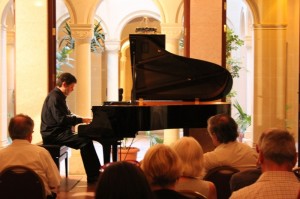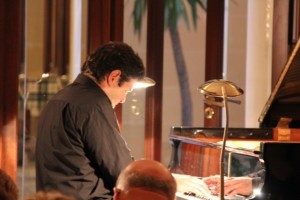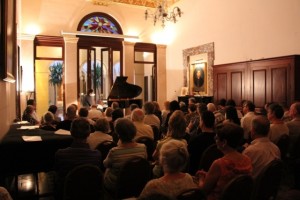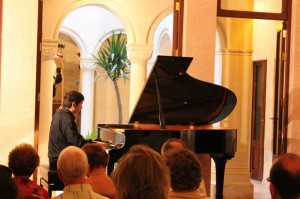Dazzling Pianoforte Recital – Gabriele Vianello
Venetian virtuoso pianist Gabriele Vianello is no newcomer to the Victoria International Arts Festival. A consummate artist with a dazzling technique, his concerts are always a sell-out (not literally, for all VIAF concerts are free of charge). The Aula Mgr G. Farrugia was packed at both ends and the audience was not disappointed.
For his programme, Vianello chose three formidable sonatas, starting with Mozart’s No. 18 in D Major KV576. Pity the pianist who relies on Mozart’s designation of K576 as a “leichte Klaviersonate” – an easy piano sonata. The work was written in 1789, shortly after the composer’s return from a largely unsuccessful concert tour of Potsdam, Leipzig, and finally, Berlin, where the Sonata may have been aimed at a princess at the Prussian court. Little came of Mozart’s journey in the way of fresh commissions, and small wonder: some have suggested that this Sonata in D Major is actually the most difficult of the composer’s eighteen Sonatas in technical terms. The technical problems come not in the sprightly thematic material, but in its thoroughly contrapuntal treatment, perhaps inspired by the composer’s visit to Leipzig and his re-acquaintance with the dormant but still enormously influential masterpieces of JS Bach. The Sonata has three movements in the usual fast-slow-fast configuration.
From the outset, Vianello established his brand, as it were. The first movement, an Allegro in a jaunty 6/8 time, abounded with imitative entrances that, taken individually, might have come from Bach inventions, but they resolved themselves into chordally-accompanied scale material; the music never lost its graceful flow and classic poise. This work, owing to its horn-call opening, has sometimes been given the nicknames of ‘Trumpet’ or ‘Hunt’ and the work’s basic intellectual attraction is established at the outset when this stereotypical figure is unexpectedly subjected to imitation. The second subject area of the exposition is extracted from the opening material in a way Haydn would have been proud of, and the development section is an especially dense contrapuntal essay. The Adagio middle movement, in A major, was delivered as a limpid melody gently darkened by chromatic runs, and the Allegretto finale, nearly as contrapuntal as the first movement, sandwiched forte, chromatic, and virtuosic treatments of its main material between the seemingly meek statements of that material that marked off the movement’s basic divisions. This is Mozart’s last piano sonata, and Vianello did great credit to this wonderful work.
Next came Beethoven’s Sonata no. 4 in Eb Major op. 7. The first movement, Allegro molto e con brio, began with throbbing chords full of anticipation, but quickly gave way to a bright, confident melody that wandered up and down the scale; it wouldn’t have been out of place in a Mozart sonata. Most of the thematic elements closely resembled each other, and they were even harder to differentiate over Beethoven’s insistent, energetic 6/8 rhythm. The development section made much of a strongly syncopated version of the second subject, then dropped back to toy a while with the first subject and all the other miscellaneous material Beethoven packed into the exposition. The Largo con gran espressione is an early example of the stately slow movements that Beethoven would later bring to extraordinary poetic heights. The measured main theme as played by Vianello was as arresting for its pauses as for its arrangement of notes; as the accompaniment became more elaborate, these pauses provided the melody with an aura of grandeur. Beethoven never loses sight of this theme during the course of the movement; he merely varies it by filling in the silences with a more legato melodic treatment, even while making the accompaniment (which shifts from bass to treble) more staccato. The Allegro third movement did not stray too far from the old minuet style, although Beethoven, characteristically, created a melody full of hesitation and little deviations from the expected harmonic path. The mood became more serious in the central trio section, churning as it did through E flat minor, but the passage is too brief to alter the movement’s essentially light-hearted character. A light mood also characterized the concluding rondo (Poco allegretto e grazioso). This is not the manic sort of finale that Beethoven would later indulge in, but a gentle frolic interrupted by a single stormy episode a quarter of the way through. This movement offered many passages of something rarely found in Beethoven’s music: an appealing sweetness.
Last on the programme featured Brahms’ monumental Sonata no. 3 in F Minor op. 5. Resurrecting the polyphonic writing of the High Baroque Period, Brahms created new wholes out of fragments. In the first movement, the apparent spatiality of the acoustic realm was of a piece with its transcendence. Vianello approached this work with extraordinary insight and intelligence, at once endowing with the full passionate palette it asks for without in any way comprising its intellectual validity. There seemed to be no real space of sounds, but there was a phenomenal space of tones. It scaled dizzy heights and abysmal depths, and its single dimension was understood by the audience not only geometrically in terms of Sonata Form, but also in terms of motion and stasis, attraction and repulsion, lightness and heaviness. Vianello created a texture permeated by a phenomenal gravity, to the law of which all tones were subject, yet paradoxically the more loaded with meaning it became the more triumphantly it soared towards the skies. This movement was characterized by a rounded, full-bodied texture that is unmistakably Brahms’s own, syncopation and cross-rhythms and modulatory shifts. The beautifully haunting second movement was structured on an expansive melodic line in Ab major. It alternated between Ab major and Db major, and these key changes are very difficult to bring off cleanly, with every note or phrase required to sing out, whatever the expressive marking, while maintaining pulse-flow at the same time. Yet, sing they did under the supple touch of Vianello. The melodies were rich and tender, poignant and passionate, full of a longing that could find no respite within temporal and spatial confines. The emotional intensity of this movement fluctuated between gaiety and sorrow, doubt and regret, within a whole panoply of expressive detail that took the pianist on a series of hazardous emotional adventures across the whole gamut of the dynamic and tonal range. The Scherzo is a brilliant movement in the original key of F minor which leads into a Trio in Db major. The contrast between these two sections of the third movement could not be more stark, with the bouncy rhythmic vitality of the Scherzo equitably balanced by the noble, sonorous and aristocratic tones of the wonderful Chorale-style writing of the Trio. A lovely Intermezzo in Gb major posited a welcome respite from the frenetic pace of the third movement and the emotional intensity of the fifth. A fast feverish introduction in 6/8 announced the last movement, again in F minor. It is heavily chromatic and rhythmically very energetic. A beautiful second section in F major brings out the idiosyncratic Brahmsian sound scape into full focus. The sweeping melodic phrases, accompanied by shimmering arpeggios on the left hand, had a Romantic textural expansiveness that is very much part of Brahms’s own sound world. A return to the F minor mode punctuated the movement with a strong momentum, full of energy and fire. What Vianello made very clear was that the very structure of Brahms’ work is the controlling force behind a very complex emotional intensity, and this was achieved by bridging the gap between the classical and romantic in his spirit. Anticipatory tension was created by short, gasping staccato phrases which generated a mood of impulsive fervour. This crackling fiery energy was smouldered by the echoing of the choral-style writing of the Trio in the third movement, providing a thematic link within the structure. The hectic contrapuntal writing yielded and gave way disarmingly to a homophonic structure, the intricate interweaving of themes was clarified into a single melodic line, complex metaphor was refined and rarefied into an eloquent simile. No sooner had the music calmed down than it built up again in a long, breath-taking section in F major, which acted as a superbly ebullient coda to bring this monumental sonata to a resounding close.
This was one performance that will live for a long time in the memories of those privileged to have been present!








